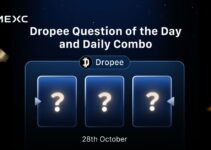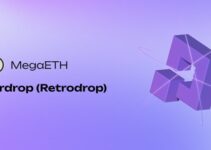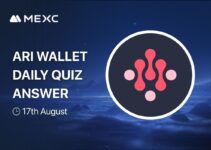The BlockMesh airdrop has become one of the most discussed opportunities in the DePIN and AI farming space. Many users are searching for clear guidance on how to qualify, how the reward structure works, and what the project aims to build over the long term. This guide brings everything together in one place with a focus on clarity, depth, and accuracy. It combines what is known publicly with practical steps from user experience and available documentation. The goal is to help you understand the airdrop process without offering predictions or financial advice. By the end, you will have a full picture of the BlockMesh ecosystem and what participation in its airdrop involves.

Disclaimer: MEXC is not affiliated with, nor does it endorse or organize, the airdrop event mentioned in this article. The airdropped tokens are not currently listed on MEXC, and there are no official plans to list them at this time. Please exercise caution and conduct your own research before participating in any airdrop or token-related activity.
Table of Contents
What Is BlockMesh?
Overview of the BlockMesh Network
BlockMesh is a decentralised data and bandwidth sharing network that allows everyday users to contribute their extra bandwidth and device resources to a shared system. The idea is simple. Instead of relying entirely on large central entities to gather and process data, the platform distributes this work across thousands of user nodes. Participants download a browser extension, allow limited resource sharing, and earn points for their contribution.
The project positions itself within the growing intersection of DePIN and artificial intelligence. DePIN, or Decentralised Physical Infrastructure Networks, uses blockchain technology to coordinate real world resources. In the case of BlockMesh, the resources are bandwidth, browsing data, and other anonymised signals that can be used to support AI training, sentiment analysis, trend prediction, and other data driven applications. This model appeals to users who want passive rewards without heavy technical setups.
Recent Rebranding and Project Evolution
BlockMesh has gone through a recent rebranding to the name Perceptron Network. This transition reflects a broader vision for the platform that goes beyond simple bandwidth sharing. Although the previous name is still widely used within the airdrop community, the new identity suggests a stronger focus on AI aligned use cases.
Users should be aware of the rebrand because it affects how the extension is presented, how forms are labelled, and how the team communicates across platforms. Despite the new name, the airdrop is still commonly referred to as the BlockMesh airdrop since that is what early adopters recognise. The change does not appear to affect the earning structure for current members.
Why BlockMesh Is Gaining Attention
Interest in BlockMesh has grown quickly for several reasons. First, the demand for decentralised infrastructure projects is increasing as AI systems require larger and more diverse datasets. Second, many users are drawn to passive earning models that do not require complex technical knowledge. Installing a browser extension and letting it run in the background is a relatively simple commitment.
The official site also mentions more than seven hundred thousand verified nodes. While these numbers should always be interpreted with caution, they signal growing adoption and curiosity. The project has also been mentioned in accelerator programs focused on decentralised infrastructure, which helps build credibility for new users evaluating the ecosystem.
What Is the BlockMesh Airdrop?
Purpose of the Airdrop
The BlockMesh airdrop serves several strategic goals. First, it rewards early users who contribute to the network before full token launch. Second, it helps the team stress test the system by attracting more active nodes. Third, it builds a foundation for community growth as the project moves toward a token generation event.
Airdrops are commonly used in Web3 to distribute ownership and encourage long term engagement. In BlockMesh’s case, the airdrop is tied to a points system that tracks user contribution across multiple activities. These points do not yet represent tokens, but they are expected to convert into token rewards once the launch details are finalised.
How the Airdrop Works
Participation starts when users create an account and install the browser extension. Once active, the extension collects data signals and bandwidth according to the permissions granted. Users earn points automatically over time. The system also includes a task layer. This allows users to increase their total points through referrals, social media promotion, content creation, or participation in community events.
The points based structure is widely used in current airdrop campaigns because it provides flexibility and encourages consistent activity. It is important to note that points are not tokens. They are simply a measure that will later be used to calculate allocations.
Token Allocation and Future Value Potential
Public information suggests that around thirty percent of the eventual token supply is reserved for community members. This indicates a strong focus on decentralisation and user participation. However, the project has not yet confirmed final tokenomics, listing details, or conversion rates.
Because these factors remain unknown, users should avoid forming expectations about specific reward amounts or potential value. The airdrop should be seen as an opportunity to contribute to a growing network rather than a guaranteed return. As with all early stage Web3 projects, plans may evolve as the team refines the product and prepares for launch.
How to Join the BlockMesh Airdrop
Step 1: Create Your BlockMesh or Perceptron Account
The first step is to register an account on the official platform. Most users sign up using a Gmail address, since this is the method supported within the extension. After entering basic details, you will receive a verification prompt in your email. Once confirmed, your account becomes active and ready for connection with your wallet.
Account creation is simple, but it is important to choose an email that you will continue using. This email will be referenced during the form submission stage of the airdrop, so consistency matters.
Step 2: Install the Browser Extension
The browser extension is the main tool for earning points. It is available for Chrome and Chromium based browsers. After installing, you must log in with the email used during registration. The extension operates quietly in the background and gathers the data signals required for network analysis.
To maximise earning potential, keep the browser open during the day. You do not need to interact with the extension constantly, but it should remain active so that the system can record your contribution.
Step 3: Link Your Solana Wallet
BlockMesh uses the Solana ecosystem for future token distribution. This means you will need a Solana wallet such as Phantom, Solflare, or Backpack. Linking your wallet associates your earning with a specific address. Make sure the wallet you choose is secure and easy to access. Once linked, it is best not to change your wallet unless necessary because the points system relies on continuity.
Users who participated early should confirm that the wallet they originally linked is the same one they intend to use for the airdrop. Matching details help avoid issues during distribution.
Step 4: Complete Tasks to Maximise Points
Beyond passive earning through the extension, users can increase their point totals through optional tasks. These include inviting friends through referral links, sharing social media posts about BlockMesh, creating short videos, and participating in campaigns run through Twitter or other platforms.
These tasks are optional. However, users who complete them typically earn more points and improve their chances of receiving a larger allocation during token distribution.
Step 5: Fill Out the Official Airdrop Form
The final step is completing the airdrop form. The form requires your Gmail account, your linked Solana wallet, and the wallet you prefer to receive rewards. You will also see optional fields for Twitter posts, YouTube videos, TikTok clips, or any other social media content you created for the project.
The form includes a question regarding reward lock periods. The video guide referenced earlier suggests selecting No unless you have a specific reason to choose a lock option. Toward the end, you will need to select your IP region. If your country does not appear in the list, select Other.
Once the form is submitted, your information is stored and will be reviewed during the allocation stage.
Step by Step Walkthrough of the BlockMesh Airdrop Form
Required Fields
The first set of fields collect essential user information. You must enter your Gmail address that is connected to your BlockMesh account. You must also provide the Solana wallet that you originally linked. These two details allow the system to match your points to your identity.
The form also asks for the Solana address where you wish to receive the reward tokens in the future. In most cases, users simply enter the same wallet for both fields to avoid confusion.
Optional Bonus Fields
The optional fields are designed to reward users who help promote the network. If you have shared a post on Twitter related to BlockMesh, you can paste the link. If you created a YouTube or TikTok video reviewing the project or explaining the extension, you can insert those links as well. Additional social media profiles or posts can be added in the extra fields provided.
Not all users will have content to share. It is perfectly acceptable to skip these fields. However, if you produce quality content, these links may strengthen your overall point score.
Choosing Reward Lock Settings
One of the form questions asks whether you want to lock your rewards after receiving them. Locking rewards usually refers to voluntary vesting, where tokens are held for a set period. The intention behind this mechanism is to support long term alignment. The video guide suggests selecting No since most users prefer immediate access once tokens are distributed. Your choice depends on your preferences, and there is no single correct option.
IP Selection
The form includes a dropdown menu for IP location. If your region is not listed, choose Other. This step helps the team understand the geographic distribution of the network. It does not affect your eligibility but is necessary for form completion.
Tips to Maximise Your BlockMesh Airdrop Rewards
Keep the Extension Running Consistently
The more consistently your extension is active, the more points you collect. You do not need to leave your computer running at all times, but avoid closing the browser completely for long periods. Occasional breaks do not harm your progress, but regular activity helps ensure stable earning patterns.
Use Referrals Strategically
Referral programs are often the most efficient way to increase your point accumulation. Share your referral link with friends who are interested in Web3, DePIN, or AI related tools. Provide clear explanations so they understand what they are joining. Honest communication builds trust and avoids misunderstandings.
Leverage Social Media for Bonus Points
Social platforms offer quick ways to earn extra points. A short post on Twitter can take less than a minute. A short review on TikTok or YouTube can also help others learn about the extension. Focus on clarity and authenticity rather than hype. High quality content tends to perform better and aligns well with the spirit of the community.
Manage Multiple Accounts Carefully
Some users operate more than one account, although this may violate platform terms depending on the project rules. If you choose to explore this path, read the guidelines carefully to avoid potential disqualification. It is safer to maintain a single account that follows all rules and contributes genuinely to the network.
Is the BlockMesh Airdrop Legit? Risks and Considerations
Signals That Support Credibility
Several factors contribute to the impression that BlockMesh is a legitimate and active project. The network has a significant user base and receives attention within the DePIN community. The website provides clear explanations of the technology, and the extension integrates smoothly with common browsers. The project has also been mentioned in accelerator tracks focused on infrastructure innovation.
While these signs are encouraging, users should remain cautious with early stage projects until tokenomics, roadmap milestones, and long term plans are fully transparent.
Common Risks to Watch For
There are several risks to consider. First, the token generation event has not been announced, which means there is no clear timeline for reward distribution. Second, token value may vary significantly once the asset is listed. Third, privacy concerns should always be reviewed when using bandwidth sharing extensions. Always read the permissions carefully and understand what data you are allowing the system to use.
Participation should be based on personal comfort level rather than expectation of specific returns.
How to Stay Updated
To stay informed, follow BlockMesh or Perceptron Network on Twitter, Discord, and Telegram. Check reputable airdrop tracking sources and keep an eye on official announcements. Verification is important since early information often circulates through unofficial channels. Use official links whenever possible to avoid phishing risks.
BlockMesh Airdrop FAQ
When Is the Token Generation Event?
The team has not released a confirmed date. Users should monitor official channels for updates.
How Many Tokens Will I Receive?
The amount depends on your point total and final conversion rates, which have not yet been announced.
Do I Need KYC?
At this time, no KYC is required for participation. Policies may change after token launch.
Can I Change My Wallet Later?
Changing wallets is not recommended because your points are tied to the wallet you originally linked. If you must change it, review instructions provided by the team.
Does the Extension Affect My Device?
The extension uses a small amount of bandwidth and system resources. Most users report minimal impact, but results can vary.
Final Thoughts: Should You Join the BlockMesh Airdrop?
Summary of Benefits
The BlockMesh airdrop offers an accessible way to explore a DePIN and AI aligned project with a low barrier to entry. Installing a browser extension is simple, and optional tasks provide opportunities for higher point accumulation. The community is active, and the project shows signs of ongoing development.
Who Will Benefit Most
Users familiar with airdrop farming and those who enjoy testing early stage tools will find the project appealing. It also suits individuals interested in decentralised infrastructure and data driven AI systems.
Balanced Closing Recommendation
The BlockMesh airdrop is worth exploring for those comfortable with early stage projects. It carries normal risks associated with token launches, and outcomes cannot be guaranteed. Participation should be based on interest in the technology rather than expectation of financial gain. With that mindset, the airdrop can be a constructive way to learn about DePIN and contribute to a growing network.
Join MEXC and Get up to $10,000 Bonus!
Sign Up


